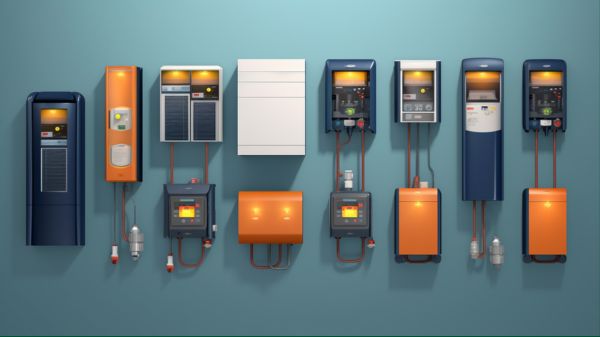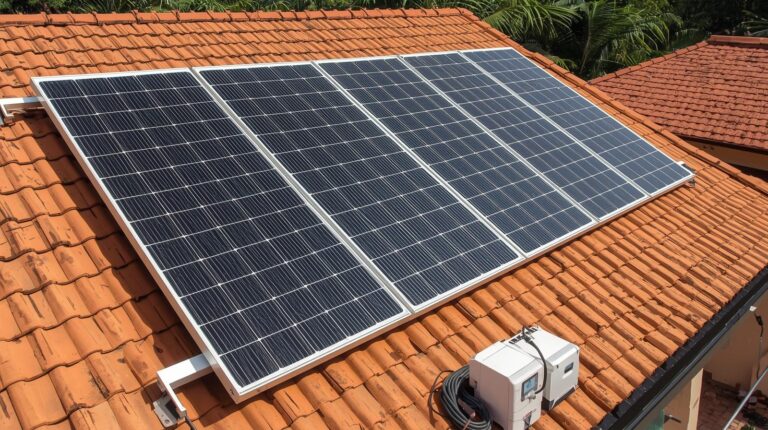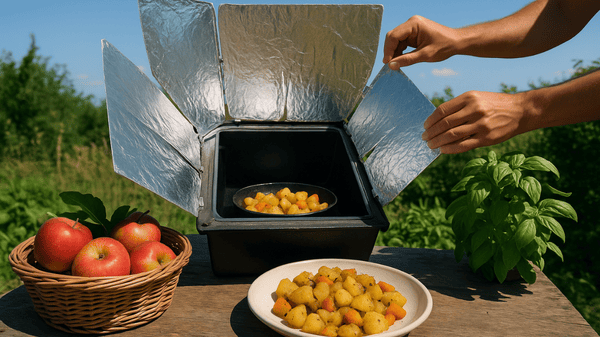Choosing the right solar inverter for small home is essential for homeowners looking to maximize the efficiency of their solar energy systems. Each type of inverter—whether it be string inverters, microinverters, or power optimizers—offers distinct advantages depending on individual circumstances such as roof shading and layout.
Furthermore, factors like inverter efficiency rates, compatibility with existing solar panels, and warranty length play pivotal roles in ensuring long-term satisfaction and system reliability. As we explore these essential considerations, it becomes apparent that the decision is not merely about initial costs but about understanding the nuances that define solar energy optimization in residential settings.
Key Takeaways
- Opt for microinverters in shaded areas to boost energy conversion by 10-20%.
- Ensure compatibility between inverter wattage and solar panel system’s total wattage.
- Select inverters with high CEC ratings and peak efficiencies above 95% for optimal performance.
- Choose inverters with extended warranties, preferably 25 years, for financial protection and reliability.
- Consider maintenance ease; string inverters offer simpler servicing than microinverters.
Understanding Solar Inverter Types
To effectively harness solar energy in small homes, it is essential to understand the distinct types of solar inverters available: string inverters, microinverters, and string inverters with power optimizers.
String inverters, the most traditional form, connect solar panels in a series, converting the DC electricity from these panels into AC electricity for home use. Their cost-effectiveness is notable, yet their efficiency can be compromised under shading conditions, as the entire string’s output is pegged to the lowest-performing panel.
Microinverters, in contrast, are installed at each solar panel, allowing them to convert DC to AC independently. This design greatly boosts energy production as each panel operates at its optimum, unaffected by the performance of others. This is particularly advantageous in areas with variable shading throughout the day.
Lastly, string inverters with power optimizers combine aspects of both technologies. Power optimizers are attached to each panel to maximize output before sending the DC electricity to a central inverter. This setup is ideal for optimizing system efficiency while keeping the energy conversion process centralized, offering a balanced solution for homes with partial shading issues.
Each technology enhances the solar panel systems’ potential, aligning with diverse residential energy needs.
Evaluating Inverter Efficiency
In evaluating solar inverter efficiency for small homes, it’s essential to measure conversion rates, which indicate how well an inverter handles the translation of DC to AC power under typical operating conditions.
The significance of peak efficiency cannot be overstated, as it reflects the maximum potential efficiency an inverter can achieve in ideal conditions; for instance, top-tier models like the SolarEdge Home Wave Inverter boast peak efficiencies reaching up to 99.20%.
Such metrics are important for homeowners looking to optimize their solar investment and guarantee sustained energy output in varying environmental scenarios.
Measuring Conversion Rates
Evaluating the efficiency of solar inverters is essential, as it determines how effectively the device converts direct current (DC) from solar panels into alternating current (AC) suitable for home use.
In the domain of small homes, where space and resource efficiency are important, selecting an inverter with high conversion rates is fundamental to maximizing the utility of a solar power system. Modern inverters generally achieve efficiencies of 95% or higher, which greatly reduces energy loss during the conversion process.
Understanding and measuring inverter efficiency involves examining several key metrics. The California Energy Commission (CEC) efficiency rating, for instance, offers insight into how an inverter performs under a variety of DC input levels, reflecting more realistic, variable environmental conditions than peak efficiency figures alone.
This CEC rating is crucial for small homeowners to evaluate, as it affects the overall performance and return on investment of the solar installation.
Importance of Peak Efficiency
Understanding the peak performance of a solar inverter is essential, as it represents the highest potential for energy conversion from DC to AC in residential solar systems. This metric is particularly critical in small home solar systems where maximizing energy output from limited space is paramount. High efficiency inverters, such as those with peak performances nearing or exceeding 99%, greatly enhance the overall energy production, ensuring that homeowners get the most out of their solar installations.
Efficiency not only impacts the immediate performance of the solar system but also contributes to long-term cost savings. By selecting a solar inverter with superior peak performance, homeowners can reduce their reliance on grid-supplied electricity, leading to noticeable reductions in energy bills.
The table below illustrates the importance of peak performance in solar inverters:
| Inverter Model | Peak Performance | Benefit |
|---|---|---|
| SolarEdge Home Wave | 99.20% | Top market performer for residential use |
| Generic Inverter Model | 95% | Standard efficiency |
| Low-End Inverter Model | 90% | Lower efficiency, reduced energy savings |
The California Energy Commission (CEC) efficiency rating provides a reliable benchmark, ensuring that the inverters perform effectively under varying real-world conditions, further underscoring the importance of selecting high-efficiency products for your solar needs.
Importance of Inverter Warranties
When selecting solar inverters for small homes, understanding the nuances of warranty length and coverage scope is essential. A robust warranty not only mitigates potential financial risks by covering repairs and replacements, but also signals the manufacturer’s confidence in their product’s durability and performance. Carefully evaluating these warranty parameters can considerably influence the long-term value and reliability of your solar power system.
Warranty Length Impact
The warranty length of solar inverters is a vital factor in determining their reliability and the manufacturer’s confidence in their product’s longevity. When selecting an inverter, the warranty length notably influences homeowner’s confidence in their investment and plays an essential role in forecasting long-term costs and benefits.
Longer warranties, such as those provided with microinverters, DC power optimizers, and advanced models like the SolarEdge Home Wave Inverter, not only underline a commitment to product durability but also assure homeowners of lower repair or replacement costs over the inverter’s lifespan.
Key Points to Reflect On:
- Standard Warranty: Typically ranges from 5 to 12 years for basic inverters, setting the baseline for manufacturer trust and product reliability.
- Extended Warranties: Offer up to 25 years of coverage, reflecting heightened security and support for your solar installation.
- Microinverters and DC Power Optimizers: These components often come with a 25-year warranty, indicating superior endurance and performance expectations.
- Long-Term Value: Products like the SolarEdge Home Wave Inverter that offer extended warranty periods may represent greater value, despite higher initial costs, due to minimized future financial risks.
Understanding these aspects of warranty length can empower homeowners to make informed decisions tailored to maximizing the benefits of solar technology.
Coverage Scope Essentials
Evaluating the scope of coverage provided by inverter warranties is fundamental for safeguarding your solar investment against unforeseen failures and defects. Inverter warranties, which can range from 5 to 25 years, are significant in appraising the reliability and long-term performance of your equipment.
Particularly, microinverters and DC power optimizers often come with the longest warranties, up to 25 years, indicating robust warranty support and manufacturer’s confidence in their products. A standard warranty for string inverters typically spans 10 to 12 years, with options available to extend this period.
These extended warranties are important as they cover repair or replacement costs that might occur once the standard warranty expires, thereby offering peace of mind and liberating homeowners from potential financial burdens associated with inverter malfunctions.
When selecting an inverter, it is crucial to scrutinize the coverage terms of the warranty. Understanding what is specifically covered and any limitations guarantees that you are well-prepared to handle any issues that might arise, ultimately securing your solar investment.
This diligence reflects a market-aware, detail-oriented approach in choosing a reliable product that promises longevity and steadfast performance in your solar power setup.
Solar Inverter Compatibility
Selecting the appropriate solar inverter requires careful consideration of the system’s voltage and wattage compatibility, as well as the specific operational requirements of grid-connected or off-grid setups. The right choice empowers homeowners to achieve energy independence, enhance efficiency, and reduce reliance on traditional power grids.
Here are key considerations to guarantee ideal compatibility and performance:
- Inverter Type: Choose between string inverters, microinverters, and power optimizers based on your particular needs. Microinverters excel in conditions with variable shading, improving overall efficiency by optimizing each solar panel individually. String inverters, on the other hand, are cost-effective for installations with consistent sunlight exposure.
- Battery Compatibility: Confirm that the inverter supports the specific type of battery storage your system utilizes, whether lithium-ion or lead-acid, to maintain system integrity and longevity.
- Hybrid Capability: Hybrid inverters offer a versatile solution by integrating solar energy production with battery storage, vital for maintaining power during outages and enhancing usage based on energy availability.
- System Requirements: Match the inverter’s wattage capacity with the total wattage of your solar panel system to prevent performance bottlenecks and maximize output efficiency.
Carefully considering these aspects will guarantee that your residential inverter serves as a cornerstone in your journey towards sustainable living.
Maintenance and Servicing Insights
Understanding the maintenance requirements and servicing options for solar inverters is fundamental for guaranteeing their long-term functionality and efficiency. Regular maintenance is vital to sustain peak energy conversion rates and prevent performance degradation.
For homeowners with string inverters, the advantage lies in their ease of access due to ground-level installation. This accessibility facilitates straightforward troubleshooting and quick resolution of issues, without the complexities of panel disassembly.
Conversely, microinverters present a unique challenge; while they excel in panel-level management, enhancing the overall system’s efficiency, their placement under each panel means servicing can be more labor-intensive. Hence, microinverters are often equipped with extended warranties, typically ranging from 5 to 25 years, reflecting their durability and the manufacturer’s confidence in their long-term performance.
Effective solar inverter maintenance also involves guaranteeing that the area around the installation remains free from dust and debris, which could otherwise impede functionality.
Additionally, maintaining open lines of communication with your installer is pivotal. This relationship guarantees that any performance anomalies are promptly addressed under the terms of existing warranties, thereby safeguarding your investment and maximizing the lifespan of your solar power system.
Mitigating Shade Impact
How can homeowners effectively mitigate the impact of shade on solar energy production? Given that shade can greatly reduce solar panel output, selecting the right solar inverters becomes essential. Particularly, microinverters and string inverters equipped with power optimizers are critical for maintaining ideal energy yield in environments where panels may be partially shaded.
- Microinverters: These enable each panel to operate independently, ensuring that shaded panels do not compromise the system’s overall performance. In shaded conditions, microinverters can enhance energy production by approximately 10-20% compared to traditional systems.
- String Inverters with Power Optimizers: These devices allow for individual panel management, which means that even if some panels are shaded, the unshaded panels will continue performing at their peak efficiency.
- Assessment of Shading Patterns: Properly evaluating how shadows fall across your solar array throughout the day can guide better panel placement and inverter selection, improving panel performance.
- Panel Orientation and Installation: Strategic positioning and angling of solar panels can minimize the time they spend under the shade, thereby maximizing the energy production potential.
Selecting the Right Inverter
After addressing how to mitigate shade impacts through appropriate inverter technologies, it is important to examine the key factors involved in choosing the most suitable solar inverter for small homes.
Selecting the right inverter type is essential. String inverters are generally cost-effective and ideal for roofs without shade, as they manage solar panels in a series. However, for homes with shaded areas, microinverters are preferable since they enhance energy conversion for each panel individually, thereby minimizing power reduction issues.
It is also critical to confirm that the inverter’s wattage is compatible with your solar panel system’s total wattage. This alignment maximizes efficiency and enhances the overall output of the system. When evaluating potential inverters, checking efficiency ratings is key—look for models offering 95% or higher to guarantee optimal energy conversion.
Moreover, consider the warranty options. Inverters come with varying lengths of warranty, ranging from 5 to 25 years. A longer warranty period can safeguard your investment by assuring long-term reliability and performance.
Lastly, choosing from reputable brands is significant. Brands well-regarded for their customer service and product quality can provide additional confidence in your investment, reflecting the importance of reliability in your solar power setup.
Related Post: Best All In One Solar Charge Controller Inverter for Solar System.
Conclusion
In summary, for small homes investing in solar energy, careful selection of solar inverters is essential. Ideal performance hinges on understanding the various types of inverters, prioritizing high efficiency, ensuring lengthy warranties, and confirming system compatibility.
Additionally, considerations of maintenance ease, shade mitigation, and choosing established brands play significant roles in maximizing energy output and reliability. Consequently, homeowners are advised to meticulously evaluate these factors to enhance sustainability and economic benefits of their solar installations.




